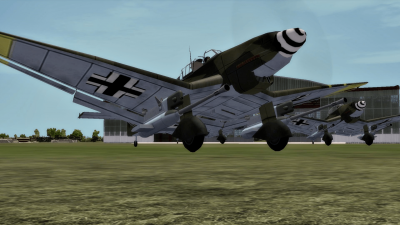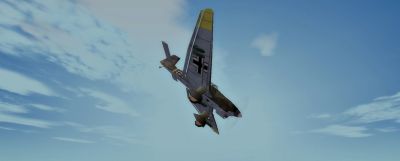Junkers Ju87B
Junkers Ju 87B
History
Few aircraft in history can claim the mystique, and notoriety, that belongs to the Junkers Ju 87 Sturzkampfflugzeug or Stuka. Without a doubt one of the least attractive combat aircraft of any era, the Stuka's menacing appearance served its role as a terror weapon almost as well as its ability to deliver its bomb load with pin-point accuracy. Its bent wing and oddly spatted fixed landing gear were unlike any contemporary combat aircraft design and have cemented its image into legend. Fitted with a siren activated on its dive run, the Stuka became an instantly recognizable weapon as soon as it was deployed.
The Stuka design was championed by Ernst Udet, the Reichluftfahrtsministerium (RLM) director who was in the main responsible for equipping the newborn German Luftwaffe. Inspired by the Curtiss Helldiver dive-bomber, Udet as well as Hitler and Göring were amazed by the accuracy of the dive-bomber concept – and accuracy meant economy, which was always a primary consideration for the German war machine. This same economical thinking of effort versus results caused Hitler to demand that all future bomber designs were to be capable of dive-bombing – a fact that stunted German aircraft design and deployment doctrine more than it helped develop it.
Highly effective when enjoying air superiority, the Stuka proved increasingly vulnerable against modern high-powered enemy fighters. This was conclusively proven during the early stages of the Battle of Britain where whole units were wiped out in veritable 'turkey shoots'. With faster and and more heavily armed fighters opposing the Ju 87, this disparity increased yet further as the war progressed. Additionally, the volume and capacity of anti-aircraft guns increased exponentially over the course of the war, further diminishing the Stuka's ability to wreak havoc.
By the end of 1942 the Ju 87 was all but obsolescent. With the introduction of the Focke Wulf 190 former bomber and close air support units were re-equipped with ground attack versions of this highly versatile fighter.
Game Play
While not especially gifted in any particular performance profile, the Ju 87s real talent lies in its dive stability and in its powerful punch. Though capable of aerobatics to a much higher degree than enemy fighters like to think, that is, once free of its ordnance, the Ju 87 is a slow aircraft by any measure, and slow speed in the climb and in level flight means increased vulnerability. For this reason it makes very good sense to employ the Stuka in its historically proven best scenario: with friendly air superiority and with full use of surprise and weight of numbers.
Assuming a best case scenario, the Stuka formation that dives from 3-4 km altitude against a known target such as a busy army base, can deliver an overwhelming weight of explosive and extricate itself without undue trouble as long as it sticks to this 'single run' philosophy. When this practice is compromised, such as in making multiple runs at subsequently lower altitudes, and braving both enemy fighters and dead-eye AA gunners, the Ju 87 begins to suffer.
The Stuka is ideally employed in relatively steep dives ranging from purely vertical to 60-degrees off the horizontal. When diving in from greater altitude than 2 km the dive brakes should be deployed (default key: S) so as to yield more sighting time In a purely vertical dive – see the dive angle instrument - the target should be all but centered in the sight. For dives at less than 90-degree angle the pilot must keep the target slightly low in the gunsight to compensate for the bomb trajectory. Veteran pilots uses the 50 kg bombs against soft targets and armoured cars while saving the main 250 kg bomb for tanks and bunkers.
For an in-depth guide to divebombing, have a look at the CAS section
Junkers Ju 87G2

| |
| Junkers Ju 87G2 Stuka | |
| Specifications | |
| Type | Dive Bomber |
| Armament | 2x 37 mm Cannons 1x 7.9 mm Machine Gun (tailgunner) |
| Crew | 2 (Pilot, Tail Gunner) |
| Weight | 5,960kg |
| Top Speed | 396km/h |
History
With the G variant, the aging airframe of the Ju 87 found new life as an anti-tank aircraft. This was the final operational version of the Stuka, built from upgraded D variants and boosting a stronger engine for a few hundred additional horse powers. The outdated and magazine fed MG 15 in the rear is replaced by a MG 81z twin mount with some armour protection for the gunner. It fires fare more rounds per minute and is fed from a belt, increasing the defensive firepower considerably even though it's still just throwing 7,92mm at the enemy. However, if you ask for an increased calibre, take a look at those two 37 mm cannons dangling under your wings. This main armament proved very potent against allied armour and inspired the Luftwaffe to retrofit or construct other planes as dedicated tank hunters with large calibre guns as well. The Kanonenvogel ("cannon-bird"), as it was nicknamed, proved very successful in the hands of Stuka aces such as Rudel who was credited with destroying over 500 tanks on the Eastern Front. However, usually flying low and slow in order to find and hit enemy ground units meant that the JU87G was very vulnerable to AA and enemy fighters, Rudel himself was shot down at least 32 times while flying Stukas.
Game Play
A better engine and increased defensive armament might sound good on paper, but the Kanonenvogel with its massive gun pods under its wings is slow, extremely sluggish and very vulnerable. Even though the engine offers a noticeable performance boost, most of this is eaten up by the massively increased air drag and wing load. The plane was never designed to fly in this configuration. So be aware of these drawbacks - especially in low turns - or you will fall out of your turn, into a spin and onto the ground. And also be aware of any flying opposition. Always make sure you got friendly fighters around at the target area because your plane just can't compete in a dogfight.
That being said, the G2 is one of the most feared threads for any allied tanker out there. While 3,7 cm is the same caliber as as with meager Pak 36, this gun is actually a Flak 37 using special AT ammunition to increase its armor penetration. Exclusively meant to take out tanks, this is still far from being able to punch a hole through the front of a Churchill. Make no mistake though: The sole reason for strapping AT guns to a plane is its potential to fire AP rounds at those spots of a tank, where they are not expected to land: on the roof and at its rear. The best penetration results will be achieved by coming in at a near 90° angle and hitting the thin roof. But this also offers the least time to aim and pull away safely so you will probably be better off coming in at low angles for starters with enough time to aim and a much easier escape route. The thin but big sides of a Sherman are a very good target to practice your aim and to find the convergence setting that's best suited for your personal approach. And it generally helps a lot to take a close look at your most common targets to identify armor plates that can be hit right-angled while coming in at a flat angle (f.e. the "fastback" of the Sherman's tail). Keep in mind that flying low, slow and in straight line makes you a perfect victim for enemy AA guns which will choose you as priority target. So try not to be too predictable. The life of a Kannonenvogel is dangerous for sure, but be assured, every axis soldier on sight will cheer if the seemingly impenetrable tank in front of him is suddenly blown up by an outdated Junkers screaming in from above to his rescue.
| Air Units in Battleground Europe | |
|---|---|
| Fighters and fighter bombers | |
| Bf 109E-1 | Bf 109E-4| Bf 109E-4B |Bf 109F-2 | Bf 109F-4 | Bf 109G-2/R1| Bf 109G-6/U4 | Bf 110C-4 | Bf 110C-4/B | Blenheim IF | Dewoitine D.520 | Fw 190A-3B | Fw 190A-4 | Hawk 75 | Hawk 81 | Hawk 87 | P-40F Kittyhawk Fighter Bomber | | Hurricane Mk I | Hurricane Mk IIb | Hurricane Mk IIc | Hurricane Mk IID | Junkers 87G2 'Stuka' | P-38 'Lightning' | Bell Model 14a / P-400 Airacobra | Model 26 / P-39N Airacobra | Spitfire Mk Ia | Spitfire Mk IIb | Spitfire Mk Vb | Spitfire Mk IXc | |
| Bombers | |
| Blenheim IV | Douglas DB-7 | Havoc Mk.I | A20C Havoc | Heinkel 111 | Junkers Ju 88A4 | Junkers 87 'Stuka' | | |
| Transport | |
| C47 'Skytrain' | Junkers 52 | |
